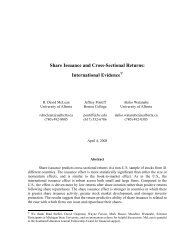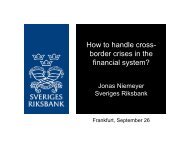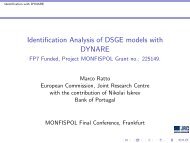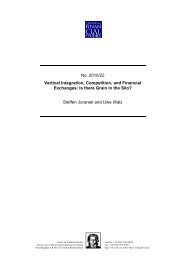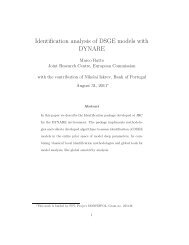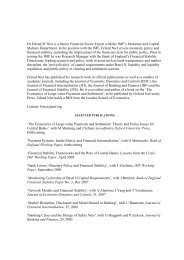Forecasting and Policy Making (Paper) - Center for Financial Studies
Forecasting and Policy Making (Paper) - Center for Financial Studies
Forecasting and Policy Making (Paper) - Center for Financial Studies
Create successful ePaper yourself
Turn your PDF publications into a flip-book with our unique Google optimized e-Paper software.
using generalized method of moments estimation. 23 Clarida et al. (2000) find that the interest rate<br />
response to inflation during the pre-Volcker period, that is from 1960 to 1979 was not sufficient to<br />
achieve stabilization. It fails the so-called Taylor principle. An increase of inflation (expectations) is<br />
followed by a less than one-to-one increase in the nominal interest rate <strong>and</strong> thus a decline in the real<br />
interest rate. Such a decline in the real interest would further stimulate economic activity, generate<br />
additional output <strong>and</strong> further upward pressure on prices resulting in faster inflation. For the Volcker-<br />
Greenspan era the inflation response coefficient is larger than 1 <strong>and</strong> consequently satisfies the Taylor<br />
principle. Over this period, the FOMC raised interest sufficiently in response to inflation <strong>for</strong>ecasts so<br />
as to ensure a stabilizing impact on inflation. The response to the four quarter ahead inflation <strong>for</strong>ecast<br />
is estimated higher than the response to the one quarter ahead inflation <strong>for</strong>ecast.<br />
Orphanides (2001) points out that actual policy decisions are better captured by using the data<br />
that was available to policy makers at that time. He analyzes the period from 1987-1993, the original<br />
sample considered by Taylor (1993). In a first step he compares interest rate rules <strong>for</strong> different <strong>for</strong>ecast<br />
horizons using ex post revised data. In this case, he finds that a specification with contemporaneous<br />
inflation <strong>and</strong> output gap estimates fits the data best. In a second step Orphanides uses Greenbook<br />
<strong>for</strong>ecasts of inflation <strong>and</strong> the output gap to estimate the policy rule. With this real-time data speci-<br />
fication he finds that policy rules with inflation <strong>and</strong> output gap <strong>for</strong>ecasts fit the data better than with<br />
inflation <strong>and</strong> output gap nowcasts. In table 2 we compare his results <strong>for</strong> one-quarter-ahead <strong>and</strong> four-<br />
quarter-ahead <strong>for</strong>ecasts with real-time <strong>and</strong> revised data. Estimates with revised data overestimate the<br />
response to inflation. Estimates with one-quarter-ahead <strong>for</strong>ecasts do not fulfill the Taylor principle.<br />
However, the response to the four-quarter-ahead inflation <strong>for</strong>ecasts is stabilizing with an estimated pa-<br />
rameter higher than unity. Orphanides (2001) also considers other <strong>for</strong>ecast horizons <strong>and</strong> finds that the<br />
coefficient on inflation increases with the horizon, while the coefficient on the output gap decreases.<br />
He notes that the <strong>for</strong>ward-looking specification captures the contours of the federal funds rate path<br />
considerably better.<br />
Orphanides <strong>and</strong> Wiel<strong>and</strong> (2008) have published updated <strong>and</strong> extended results regarding the<br />
interest rate rules in the Lindsey et al. (1997) study with FOMC <strong>for</strong>ecasts. They confirm the earlier<br />
finding of a strong response of the funds rate to FOMC inflation <strong>and</strong> unemployment <strong>for</strong>ecasts.<br />
Estimated values are surprisingly close to the Lindsey et al estimates with 10 years of additional data.<br />
A rule with FOMC <strong>for</strong>ecasts fits the data much better than an outcome-based rule. We will analyze<br />
<strong>and</strong> extend the the estimation of Orphanides <strong>and</strong> Wiel<strong>and</strong> (2008) in more detail in the next subsection.<br />
<strong>Studies</strong> of ECB policy<br />
As demonstrated by Gerlach <strong>and</strong> Schnabel (2000) average interest rates in the EMU countries in<br />
the period leading up to the <strong>for</strong>mation of European Monetary Union (EMU), that is from 1990 to 1998<br />
moved very closely with average output gaps <strong>and</strong> inflation as suggested by the Taylor (1993) rule. The<br />
only exception noted by these authors was the period of the crisis of the European Monetary System<br />
(EMS) in 199293.<br />
23 A possible justification <strong>for</strong> the differential horizons is that output affects inflation with a lag.<br />
20



